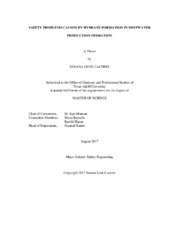| dc.description.abstract | Although hydrate formation phenomenon has been identified for many years, this is still one of the most challenging problems in oil & gas industry as they are associated with flow assurance problems and safety issues. Although, many studies have focused on developing thermodynamic and kinetic models to understand and predict hydrate formation, this phenomenon is not fully understood and there is not a general methodology for the quantification of the risk that considers the uncertainty associated with key input parameters. Therefore, there is a need for developing risk assessment methodologies, which considers, not only the models for predicting hydrates, but also the organizational factors associated with the hydrate management system.
In this work, a comprehensive framework was developed for estimating the risk of hydrate formation in a subsea production operation taking into consideration the effectiveness of the entire hydrate management system. The proposed framework was divided in three areas: 1) definition of causal and consequence models; 2) application of Bayesian Networks; and 3) sensitivity analysis of the thermodynamic or kinetic models.
In order to probe the concept and illustrate the application of the proposed framework, a hypothetical case study was created based on literature data and inputs provided by flow assurance experts from academia and industry. Causal and consequence models were developed, including a visual representation of the preventive and mitigative measures. The hydrate equilibrium curves were generated using PVTsim Nova software, and the uncertainty analysis was done with Latin Hypercube Method and statistical iii calculations. The Bayesian Networks method was used to understand the complexities associated with the Hydrate Management System. This model solved with AgenaRisk software using discrete and continuous distributions.
The results of this work include the visual representation of the probabilistic relationship between certain components and variables of a typical hydrate management system, which can affect the reliability of the control and preventive measures for hydrate control. The probability values calculated in this case study were in agreement with likelihood values typically used in a risk matrix, which probes that the proposed approach is a good starting point for future improvements to the proposed framework. | en |


